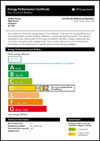|
Energy Performance Certificates - Commercial
From 6 April
2008 energy performance certificates will be needed when commercial buildings are built, sold or rented. Public buildings
throughout England and Wales will need to display an energy certificate from October 2008 (similar legislation will also apply
to Scotland and Northern Ireland).
These certificates must be produced by an accredited energy assessor.
There are two types of energy certificate:
- The Energy Performance Certificate, which is required for all buildings when they are constructed, sold or let.
- The Display Energy Certificate, which is required for public buildings and those occupied by public authorities which provide a public service to a large number of people - these will show the actual energy usage of a building and need to be displayed at all times from 1 October 2008.
What contributes to the energy performance of a building
· the type of construction of the building (including walls, roofs, floors and glazing and their thermal performance)
· whether parts (zones) of the building are used for different purposes eg office, factory etc, and the occupancy profile for each zone
· heating, cooling, ventilation and hot water systems used and their seasonal efficiency
· type of lighting and associated control
· the use of sustainable/low carbon technology (solar water heating, ground source heat pumps, wind turbine etc)
The energy performance of non-dwelling is shown as a CO2 based index. The CO2 based rating a building receives depends on the energy used for space heating, water heating, ventilation and lighting, less any energy generated from energy generation technology installed in the building (such as solar water heating). The lower the number (on a scale of 0-150+), the lower the typical CO2 emissions.What an energy assessment involves
The Simplified Building Energy Model (SBEM) or Dynamic Simulation Software (DSM) assesses the energy demands of each individual space in the building in accordance with the activity conducted within that space (examples being office space, kitchens, storage space etc).
Different activities can result in different periods of occupancy and different required temperatures, as well as varying requirements for lighting and hot water supply. The energy consumption and carbon dioxide emissions are calculated by considering these demands in relation to the details of the building services.Recommendations with an Energy Performance Certificate
The recommendation report that is included with an EPC will help to improve the energy rating of a building. The recommendations only include those improvements that are appropriate for the building that has been assessed. For each recommendation indicative paybacks are noted. The recommendations are provided in four categories those:· with a short term payback – less than three years
· with a medium term payback – between three and seven years
· with a long term payback – greater than seven years
We are pleased to advise that Caine Consulting Engineers Ltd are Accredited Energy Assessors (STROMA Accreditation)
We would be delighted to guide and support you through the process.
For further information and advice please contact:

